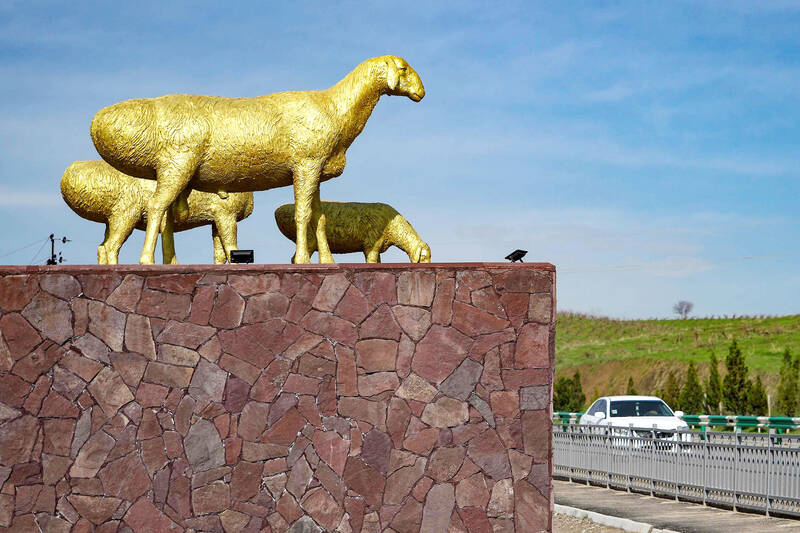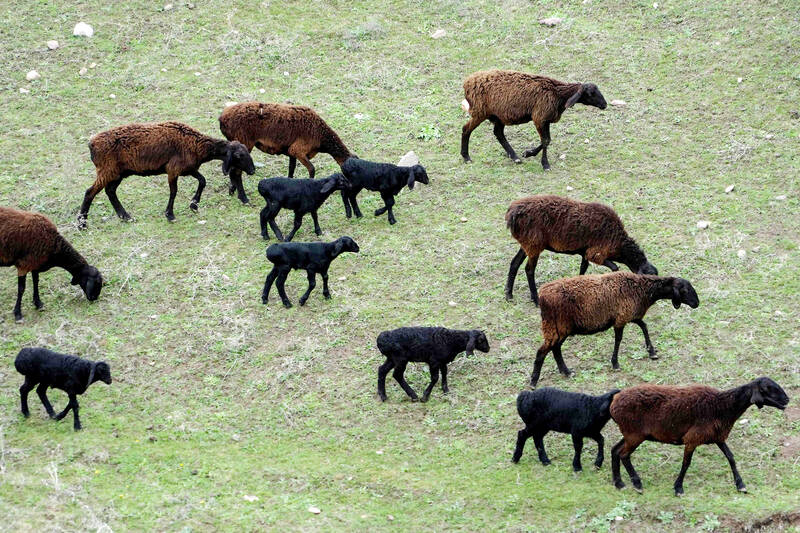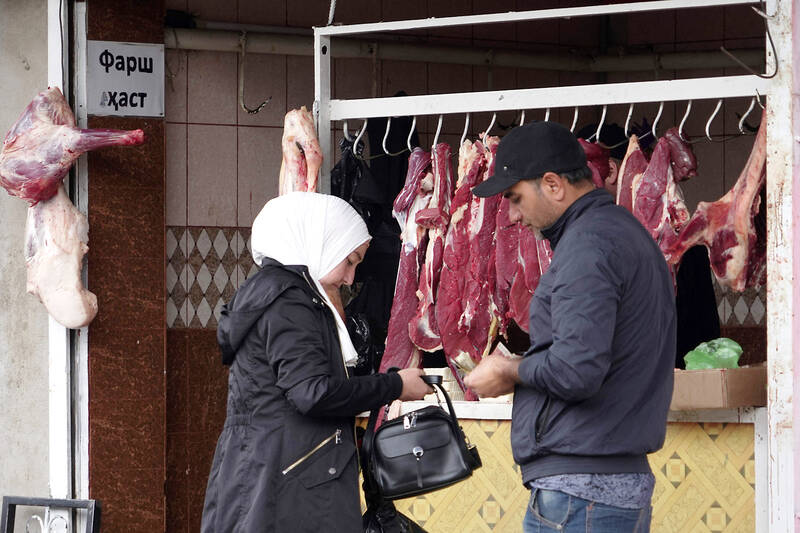In the hills outside the Tajik capital Dushanbe, shepherd Bakhtior Sharipov was watching over his flock of giant Hissar sheep.
The breed, prized for profitability and an ability to adapt to climate change, garners celebrity status in the Central Asian country, which is beset by a shortage of both meat and suitable grazing land.
“They rapidly gain weight even when there is little water and pasture available,” 18-year-old Sharipov said.

Photo: AFP
Facing a serious degradation in farmland due to years of overgrazing and global warming, the hardy sheep offer a potential boon to Tajikistan’s farmers and plentiful supply of mutton to consumers.
Around 250 of the animals — instantly recognizable by two fatty lumps on their rear end — were grazing in the early spring sun under Sharipov’s watch. “These weigh an average of 135 kilograms (300 pounds). It’s the end of winter, so they’re not as heavy, but they’ll put on weight quickly,” he said.
A white Central Asian shepherd dog, almost as large as the sheep he was watching over, stood on guard.

Photo: AFP
The largest Hissar rams can weigh over 210 kilograms (460 pounds).
Able to yield meat and fat of around two-thirds their total weight — more than most other breeds, many of which also consume more — they can be highly profitable for farmers.
‘IMPROVE THE LAND’

Photo: AFP
“The Hissars are a unique breed, first because of their weight,” said Sharofzhon Rakhimov, a member of the Tajik Academy of Agricultural Sciences.
“Plus these sheep never stay in the same spot so they contribute to improving the land’s ecosystem,” he said. They can wander up to 500 kilometers (300 miles) in search of grazing land between seasons, helping pastures in different regions regenerate. The decline in land quality is one of the main environmental challenges facing Central Asia. Around 20 percent of the region’s land is already degraded, affecting 18 million people, according to a UN report.
That is an area of 800,000 square kilometers (nearly 310,000 square miles), equivalent to the size of Turkey.
The dust churned up by the arid ground can fuel cardio-respiratory diseases.
Facing a hit to their livelihoods as their land becomes ever less productive, many farmers choose to emigrate.
In such an environment, the status of Hissar sheep — able to thrive in the tough conditions — is of serious public interest for Tajikistan.
Among the dozens of posters glorifying Tajik President Emomali Rahmon that line the road into the Hissar valley, stands a golden-colored monument to the three kinds of Hissar sheep.
EXPENSIVE SHEEP
At his biotech center near the capital, scientist and breeder Ibrokhim Bobokalonov harnesses genetic samples of the very best specimens in the hope of rearing the largest and most profitable sheep. “Demand for Hissar sheep is growing not only in Tajikistan, but also in Kazakhstan, Kyrgyzstan, Russia, Turkey, Azerbaijan, China and even the US,” Bobokalonov said.
The animals have even become a source of rivalry in the region.
Tajikistan recently accused its neighbors of tampering with the breed, crossing it with other local varieties to create even heavier sheep.
A Hissar weighing 230 kilos was recorded at an agricultural competition in Kazakhstan last year, setting a Guinness World Record. Others in Kyrgyzstan have surpassed 210 kilos. Tajik breeders say they are intent on staying ahead. “Here’s Misha. He weighs 152 kilograms and is worth $15,000,” Bobokalonov said, standing in front of a sheep lying on the scales with its legs tied together.
The sum is equivalent to six years’ average salary in Tajikistan. Bobokalonov plans to sell him later this year.
“I hope that by the time of the competition this summer, he will weigh 220-230 kilograms. Just by feeding him natural products, without doping, he can put on around 800 grams a day,” Bobokalonov said.
In Kazakhstan, a sheep sold for US$40,000 in 2021.
While farmers like the Hissars for their profitability, the sheep is famed among the wider population for its flavor.
Mutton is an essential ingredient in central Asian fare.
Scouring the offering at a local market, shopper Umedjon Yuldachev agreed.
“You can cook any Tajik national dish with this mutton.”

In the March 9 edition of the Taipei Times a piece by Ninon Godefroy ran with the headine “The quiet, gentle rhythm of Taiwan.” It started with the line “Taiwan is a small, humble place. There is no Eiffel Tower, no pyramids — no singular attraction that draws the world’s attention.” I laughed out loud at that. This was out of no disrespect for the author or the piece, which made some interesting analogies and good points about how both Din Tai Fung’s and Taiwan Semiconductor Manufacturing Co’s (TSMC, 台積電) meticulous attention to detail and quality are not quite up to

April 21 to April 27 Hsieh Er’s (謝娥) political fortunes were rising fast after she got out of jail and joined the Chinese Nationalist Party (KMT) in December 1945. Not only did she hold key positions in various committees, she was elected the only woman on the Taipei City Council and headed to Nanjing in 1946 as the sole Taiwanese female representative to the National Constituent Assembly. With the support of first lady Soong May-ling (宋美齡), she started the Taipei Women’s Association and Taiwan Provincial Women’s Association, where she

Chinese Nationalist Party (KMT) Chairman Eric Chu (朱立倫) hatched a bold plan to charge forward and seize the initiative when he held a protest in front of the Taipei City Prosecutors’ Office. Though risky, because illegal, its success would help tackle at least six problems facing both himself and the KMT. What he did not see coming was Taipei Mayor Chiang Wan-an (將萬安) tripping him up out of the gate. In spite of Chu being the most consequential and successful KMT chairman since the early 2010s — arguably saving the party from financial ruin and restoring its electoral viability —

It is one of the more remarkable facts of Taiwan history that it was never occupied or claimed by any of the numerous kingdoms of southern China — Han or otherwise — that lay just across the water from it. None of their brilliant ministers ever discovered that Taiwan was a “core interest” of the state whose annexation was “inevitable.” As Paul Kua notes in an excellent monograph laying out how the Portuguese gave Taiwan the name “Formosa,” the first Europeans to express an interest in occupying Taiwan were the Spanish. Tonio Andrade in his seminal work, How Taiwan Became Chinese,